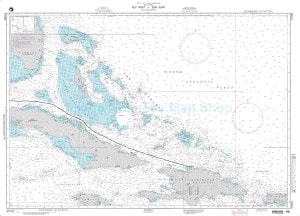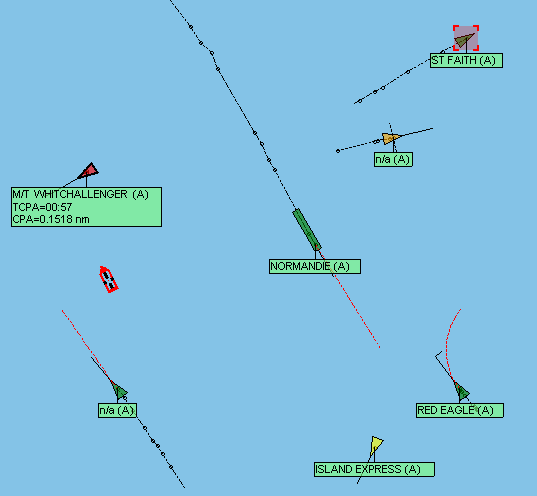We entered the North Atlantic today leaving the shelter of the Bahama Banks behind. However the weather is very good with very little swell resulting in no ships movement at all. It remained windy though with an average of 27 knots on the bow, creating a relative wind on the bow of 43 knots. Not pleasant to lean into but the Lower Prom – walk around – deck is enclosed at the front and thus still not a problem to walk around in.
When the ship clears Cuba it crosses the Windward Passage, which is located between the East point of Cuba, Cabo Maisi and the west side of Haiti. It is a gap through which a lot of traffic enters or leaves the Caribbean Sea. When inside the passage the traffic is regulated by a Traffic Separation scheme. Once through it is a free for all and the ships scatter to all directions. That makes it very interesting for the navigators as the behavior of the ships is not predictable anymore.
To keep track of what those ships are doing and whether they are of concern to us there are a number of support systems available. First of all there is the bottom line: keep a good look out, by looking out of the bridge windows. Secondly keep a good eye on the Radar as it can pick up targets much farther way than the naked eye can see. Within a range of 24 miles every blip on the screen is plotted (checked for its movement: e.g. direction and speed) and that gives a good idea what could become a problem or not.
The information seen on the Radar screen when clicking on the vessels icon. A read out on the side of the Radar screen with some the pertinent information needed for the Navigator.
Then there is a more recent invention which is another Aid to help make up the Navigators mind whether something is of concern or not. It is an Aid, as it is not fail safe and thus you cannot rely on it. It is Called A.I.S Automatic Identification System. It sends out ships specific information which is beamed up to satellites and then beamed down again to other ships. Every ship which has a receiver can display this information either on the AIS receiver itself or on the Radar Screen. If the display says that the ship is going to New York, the navigator will get a pretty good idea which course it will follow once coming out of the Windward Passage and going north. But the information is entered by humans, thus we come across ships who think it is funny to have strange messages transmitted. I remember a small ship on the Thames in England who displayed its destination as: From Here to Infinity.
Still, keeping a good look out, using the radar properly and using the AIS as well gives the Navigator a very good idea about what is going on. And then it is just monitoring if the ships keeps doing what they were doing and apply the Collision Regulations properly, so we do not get a collision. To run a bridge watch there is a team of 4 while in open Sea. Two Navigators and two Quartermasters. One navigator is the senior and is officially in charge of a watch, the other is the assistant. If both have the same seniority then the captain decides who is in charge. The two quartermasters rotate on a 30 minute cycle between keeping a look out and steering, or being on standby for steering.
Once the traffic gets more hectic, this bridge team is augmented with an extra officer who holds a master License. If the ship in a very hectic area or entering or leaving port, the Master is on the bridge as well. Normally the team then counts at least 4 officers and two quartermasters. What they are doing during such an evolution can vary in tasks. Something nice to blog about on another sea day.
The weather front I mentioned yesterday is delayed a little bit. Initial forecasts indicated that it would hit Puerto Rico during our stay, during the day; now it looks that it will come over during the night or the next day when we are in St. Thomas. So we will wait and see, there is not much we can do about it and as we have to visit the ports on our schedule, we cannot sail around it.
Tomorrow we should be at the pilot station around 11 am. And be alongside by noon time. We will dock at Pier 4 west and have the Carnival Splendor on our Starboard side and the Independence of the Seas on our Port Side.



Leave a Reply